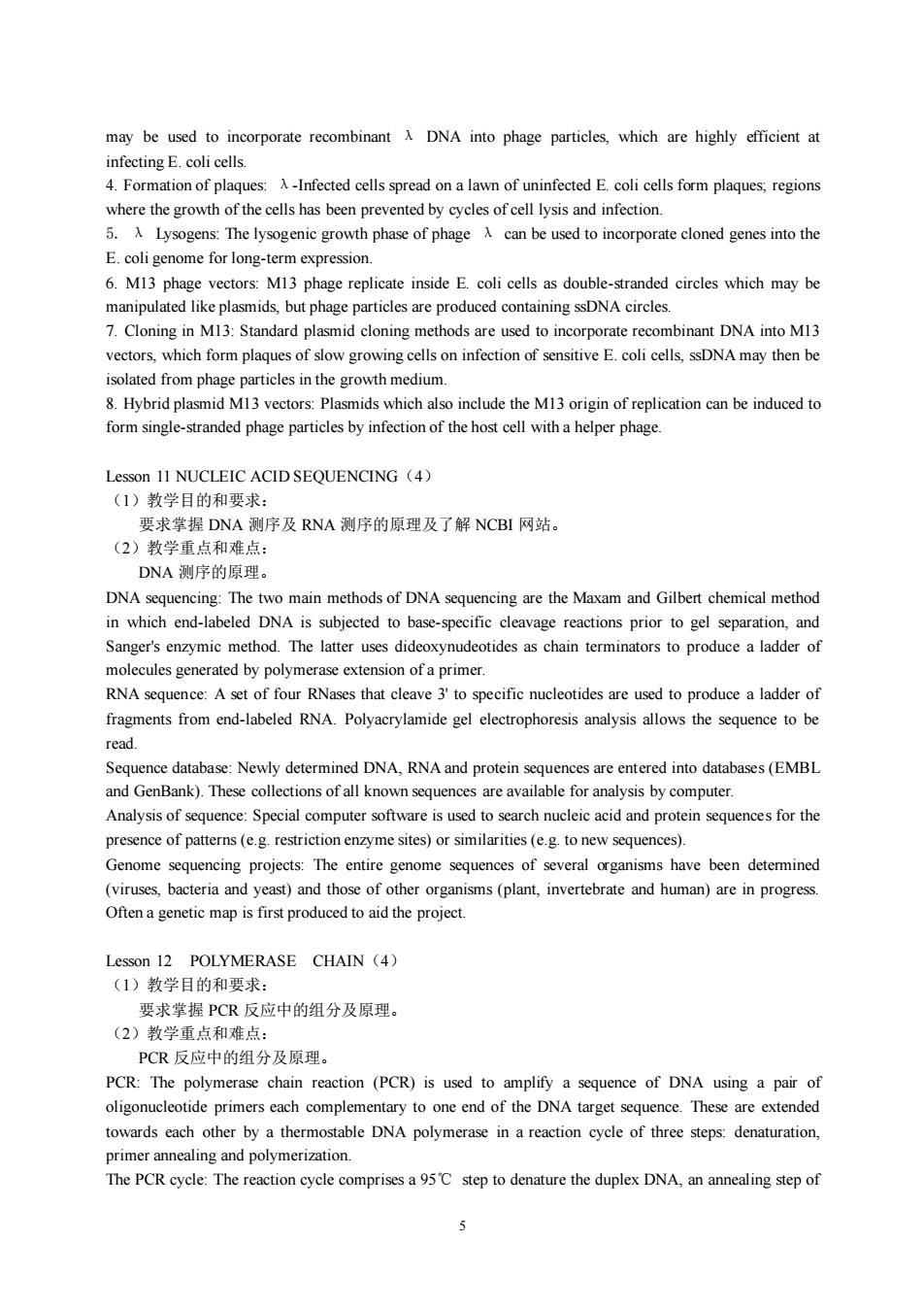正在加载图片...

may be used to incorporate recombinant DNA into phage particles.which are highly efficient at -Infected cells spread onalawn of uninfected E.coli cells form plaques,regions where the growth of the cells has been prevented by cycles of cell lysis and infection. 5.Lysogens:The lysogenic growth phase of phage can be used to incorporate cloned genes into the E.coli genome for long-term expression. 6.M13 vectors M phage replicate inside E.as doubleranded which may be smids,but phage particles are produced containing ssDNA circles 7.Cloning in M13:Standard plasmid cloning methods are used to incorporate recombinant DNA into M13 vectors,which form plaques of slow growing cells on infection of sensitive E.coli cells,ssDNA may then be isolated from phage particles in the growth medium. 8.Hybrid plasmid M13 vectors:Plas ids which also include the M13 or gin of replicationcan be induced to form single-tranded phage particles by infectio of the host cell withahelper phage Lesson 11 NUCLEIC ACID SEOUENCING (4) (1)教学目的和要求: 要求掌握DNA测序及RNA测序的原理及了解NCBI网站。 (2)教学面占和难占 DNA测序的原理 DNA sequencing:The two main methods of DNA sequencing are the Maxam and Gilbert chemical method in which end-labeled DNA is subjected to base-specifie cleavage reactions prior to gel separation,and Sanger's enzymic method.The latter uses dideoxynudeotides as chain terminators to produce a ladder of molecules g erated by polymerase extension of a primer. RNA of four RNases that cleaveto specife nucleotides re used to produce a ladder of fragments from end-labeled RNA.Polyacrylamide gel electrophoresis analysis allows the sequence to be read. Sequence database:Newly determined DNA.RNA and protein sequences are entered into databases(EMBL and GenBank).These collections of all known sequences are available for analysis by computer. tein sequences for the presence of patterns(e.g.restriction enzyme sites)or similarities(e.g.to new sequences). Genome sequencing projects:The entire genome sequences of several organisms have been determined (viruses.bacteria and yeast)and those of other organisms(plant,invertebrate and human)are in progress Ofena genetic map is first produced to aid the project 12 POLYMERASE CHAIN (4) (1)教学目的和要求: 要求掌握PCR反应中的组分及原理。 (2)教学重点和难点: PCR反应中的组分及原理】 of oligonucleotide primers each complementary to one end of the DNA target sequence.These are extended towards each other by a thermostable DNA polymerase in a reaction cycle of three steps:denaturation, primer annealing and polymerization. The PCR cycle:The reaction cycle step to denature the duplex DNA,an annealing step of5 may be used to incorporate recombinant λ DNA into phage particles, which are highly efficient at infecting E. coli cells. 4. Formation of plaques: λ-Infected cells spread on a lawn of uninfected E. coli cells form plaques; regions where the growth of the cells has been prevented by cycles of cell lysis and infection. 5. λ Lysogens: The lysogenic growth phase of phage λ can be used to incorporate cloned genes into the E. coli genome for long-term expression. 6. M13 phage vectors: M13 phage replicate inside E. coli cells as double-stranded circles which may be manipulated like plasmids, but phage particles are produced containing ssDNA circles. 7. Cloning in M13: Standard plasmid cloning methods are used to incorporate recombinant DNA into M13 vectors, which form plaques of slow growing cells on infection of sensitive E. coli cells, ssDNA may then be isolated from phage particles in the growth medium. 8. Hybrid plasmid M13 vectors: Plasmids which also include the M13 origin of replication can be induced to form single-stranded phage particles by infection of the host cell with a helper phage. Lesson 11 NUCLEIC ACID SEQUENCING(4) (1)教学目的和要求: 要求掌握 DNA 测序及 RNA 测序的原理及了解 NCBI 网站。 (2)教学重点和难点: DNA 测序的原理。 DNA sequencing: The two main methods of DNA sequencing are the Maxam and Gilbert chemical method in which end-labeled DNA is subjected to base-specific cleavage reactions prior to gel separation, and Sanger's enzymic method. The latter uses dideoxynudeotides as chain terminators to produce a ladder of molecules generated by polymerase extension of a primer. RNA sequence: A set of four RNases that cleave 3' to specific nucleotides are used to produce a ladder of fragments from end-labeled RNA. Polyacrylamide gel electrophoresis analysis allows the sequence to be read. Sequence database: Newly determined DNA, RNA and protein sequences are entered into databases (EMBL and GenBank). These collections of all known sequences are available for analysis by computer. Analysis of sequence: Special computer software is used to search nucleic acid and protein sequences for the presence of patterns (e.g. restriction enzyme sites) or similarities (e.g. to new sequences). Genome sequencing projects: The entire genome sequences of several organisms have been determined (viruses, bacteria and yeast) and those of other organisms (plant, invertebrate and human) are in progress. Often a genetic map is first produced to aid the project. Lesson 12 POLYMERASE CHAIN(4) (1)教学目的和要求: 要求掌握 PCR 反应中的组分及原理。 (2)教学重点和难点: PCR 反应中的组分及原理。 PCR: The polymerase chain reaction (PCR) is used to amplify a sequence of DNA using a pair of oligonucleotide primers each complementary to one end of the DNA target sequence. These are extended towards each other by a thermostable DNA polymerase in a reaction cycle of three steps: denaturation, primer annealing and polymerization. The PCR cycle: The reaction cycle comprises a 95℃ step to denature the duplex DNA, an annealing step of